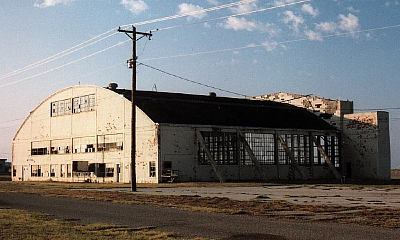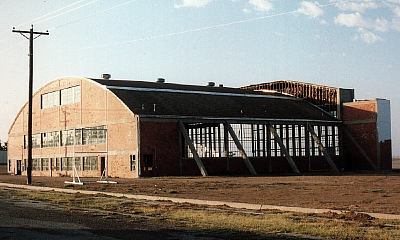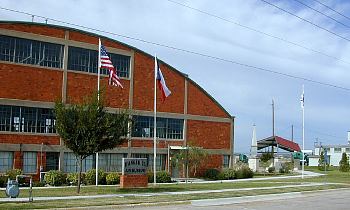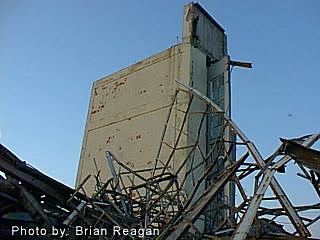|
Hangar 25 lay dormant, slowly deteriorating, until the mid 1990s when a small group of citizens took action to restore and preserve the facility, and convert it to a museum reflecting the heritage of the men and women who served our country.
 When Webb Air Force Base closed in 1977, a major portion of the former installation was turned over to the city of Big Spring, Texas. In January 1993, the Big Spring Air Park Development Board was formed under then Assistant City Manager, Tom Decell. Mr. Decell later hired Nelda Reagan as secretary for the airport and industrial park. When Mr. Decell retired in May of 1995, Ms. Reagan became the primary contact between the Air Park Board and the City of Big Spring. During this time, board member Bobby McDonald voiced his concern that no representative symbol reflecting World War II existed at the Air Park. He noted the existence of two vintage WW II hangars, structures that once sheltered people later referred to by writers as "The Greatest Generation". Historic records indicate that during the time of the bombardier school and later Webb AFB, some 5,000 bombardiers were trained and later 14,000 United States and foreign military officers earned their wings at Webb AFB.
When Webb Air Force Base closed in 1977, a major portion of the former installation was turned over to the city of Big Spring, Texas. In January 1993, the Big Spring Air Park Development Board was formed under then Assistant City Manager, Tom Decell. Mr. Decell later hired Nelda Reagan as secretary for the airport and industrial park. When Mr. Decell retired in May of 1995, Ms. Reagan became the primary contact between the Air Park Board and the City of Big Spring. During this time, board member Bobby McDonald voiced his concern that no representative symbol reflecting World War II existed at the Air Park. He noted the existence of two vintage WW II hangars, structures that once sheltered people later referred to by writers as "The Greatest Generation". Historic records indicate that during the time of the bombardier school and later Webb AFB, some 5,000 bombardiers were trained and later 14,000 United States and foreign military officers earned their wings at Webb AFB.
In 1994, Ms. Reagan accepted a leadership role and led the board through many accomplishments. She listened patiently to frequent reminders from Mr. McDonald for a historic symbol, even as the old hangar buildings were identified for demolition. In a surprise announcement at a regular Air Park Board meeting, she described the possibility of a grant for historic preservation. For months, she had quietly researched federal grants before advising the Board of her efforts and findings. One grant particularly suited this purpose. "Transportation Enhancements" are eligible activities in the Surface Transportation Program (STP), one of the federally funded federal aid transportation programs created under the "Intermodal Surface Transportation Efficiency Act" (ISTEA) of 1991. This law allowed the Texas Department of Transportation (TXDOT) to expand it's activities beyond traditional highway and public transportation projects to include projects that will both support and enhance the enjoyment of the state transportation enhancement value of each project. The grant was researched and contacts made with local officials, State of Texas, and United States representatives for letters of support. From December, 1995 to February, 1996, letters of support were received from John Montford, Texas State Senate, Charles Stenholm, United States Congress and Phil Gramm, United States Senate.
Ms. Reagan wrote the grant to restore Hangar 25 and it was awarded in the fall of 1996 for a total of $458,880.00 with a local match of $114,720.00. Raising the required matching funds was envisioned as a major hurdle and a near impossible task. And so it began. Finally, authorization to obtain the grant was received from TXDOT to work in unison with the City of Big Spring and a dedicated group of volunteer citizens.
 Several months after approval of the TXDOT grant and as the bids were about to be let, Big Spring suffered a severe wind and hail storm that further damaged the roof of Hangar 25, as can be seen at right. Realizing that the TXDOT grant would not cover the additional repairs, the TXDOT Grants Division was queried concerning the possibility of changing the location to the more structurally sound Hangar 44. The TXDOT responded that the name on the grant application could not be changed, but since the sister building was identical and in the same general location, Hangar 44 could be restored using the name, "Hangar 25 Air Museum".
Several months after approval of the TXDOT grant and as the bids were about to be let, Big Spring suffered a severe wind and hail storm that further damaged the roof of Hangar 25, as can be seen at right. Realizing that the TXDOT grant would not cover the additional repairs, the TXDOT Grants Division was queried concerning the possibility of changing the location to the more structurally sound Hangar 44. The TXDOT responded that the name on the grant application could not be changed, but since the sister building was identical and in the same general location, Hangar 44 could be restored using the name, "Hangar 25 Air Museum".
With regard to the name change, there were concerns among persons who had been stationed at Webb. However, a large portion of the north wall of Hangar 25 Air Museum was restored using bricks and boards salvaged from the damaged hangar. Likewise, the Museum sign, installed in 2004, uses bricks salvaged from the original hangar. So, some of Hangar 25 is still with us, incorporated into the renovation. Since the completion of the museum, the Corps of Engineers demolished the condemned building which was Hangar 25. There are only pictures and a concrete slab now of the old hangar. The fate of Hangar 44 would have been certain demolition also, had it not been for the efforts of the Airpark Board and the Hangar 25 Restoration Committee.

Despite numerous obstacles, the working group proceeded. At left you can see the restoration underway in 1998. The white paint is being stripped from all surfaces to expose the orange/red brick.
In 1999 the task was complete, to provide Big Spring with a restored Hangar 44 to be known as "Hangar 25 Air Museum", a symbol of the rich history of a historic city and the legacy that Big Spring was once a world influence for good, in a time when democracy and freedom were threatened.

A great debt of gratitude is owed to the visionaries mentioned in this story, as well as several others. Because of their perseverance and tireless efforts, Hangar 25 Air Museum now looks like this. 

 Not like this. Not like this.
|

